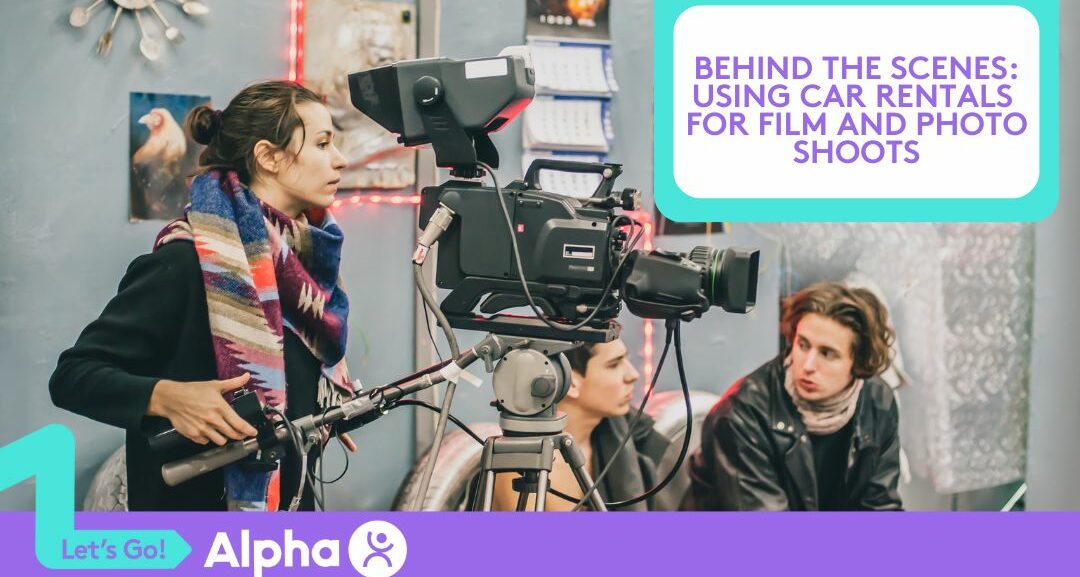Transportation plays a crucial role in the success of film and photo shoots. Whether you’re transporting equipment, crew members, or creating visual interest, having the right vehicles at your disposal can significantly impact the quality and efficiency of your production. Car rental services offer a flexible and cost-effective solution for filmmakers and photographers.
This article will explore the benefits of using car rentals for film and photo shoots, discuss factors to consider when choosing the right vehicles and delve into the various roles cars can play in productions.
Choosing the Right Car Rental for Your Production
When selecting car rentals for your film or photoshoot, several factors need to be considered:
- Production Needs: Assess your specific requirements. Do you need vehicles to transport large equipment, crew members, or both? What type of setting are you shooting in?
- Location: Consider the location of your shoot. Are you filming in a remote area where public transportation is limited? Will you need vehicles with specific features to navigate certain terrains?
- Budget: Determine your budget for car rentals. Factor in the rental fees, insurance, and any additional charges.
Types of vehicles available for film and photo shoots include:
- Cars: Sedans, SUVs, or convertibles can be used for transporting crew members or creating visual interest in scenes.
- Trucks: Pickup trucks are ideal for hauling large equipment, such as cameras, lighting, and sound equipment.
- Vans: Vans offer ample space for transporting equipment and crew members, making them suitable for larger productions.
- Specialty Vehicles: For specific needs, consider renting specialty vehicles like classic cars, motorcycles, or buses.
Additional features to look for in car rentals include:
- Camera mounts: If you plan to shoot from inside the vehicle, ensure it has suitable mounts for cameras.
- Power outlets: For charging equipment, look for vehicles with power outlets.
- Interior space: If you’ll be filming inside the vehicle, consider the interior space and comfort for the actors and crew.
The Role of Cars in Film and Photo Shoots
Cars play a multifaceted role in film and photo shoots:
Practical Use
- Equipment Transportation: Cars are indispensable for transporting heavy and bulky equipment, such as cameras, lighting rigs, sound equipment, and props. This ensures that everything is readily available on set.
- Crew Transportation: Vehicles are used to transport crew members to and from locations, especially when shooting in remote areas. This saves time and ensures that the team is ready to work when they arrive on set.
- Mobile Workshops or Dressing Rooms: Some productions may use cars as mobile workshops or dressing rooms, providing a convenient space for crew members to work or actors to get ready.
Creating Visual Interest
- Setting the Scene: Cars can help establish the setting or atmosphere of a scene. For example, a vintage car can evoke a sense of nostalgia, while a sleek sports car can convey a sense of luxury or excitement.
- Visual Elements: Cars can serve as visual elements within the frame, adding depth, composition, or framing to a shot.
- Symbolism: Cars can be used symbolically to represent characters, their personalities, or their journeys.
Incorporating Cars into Storytelling
- Narrative Elements: Cars can be integral to the narrative, serving as a plot device or a character in their own right.
- Character Development: Cars can be used to reveal a character’s personality, values, or lifestyle.
- Action Sequences: Cars can be used in exciting action sequences, such as car chases or stunts.
Car Rental Tips for Productions
Booking in Advance and Planning Ahead
- Plan: Anticipate your vehicle needs based on the script, location, and production schedule.
- Book early: To ensure availability, especially during peak seasons or for specialized vehicles, book well in advance.
- Consider alternatives: If specific vehicles are unavailable, explore alternatives like using personal vehicles or renting from multiple providers.
Understanding Rental Agreement Terms and Conditions
- Read carefully: Review the rental agreement thoroughly to understand the terms, conditions, and any additional fees.
- Insurance coverage: Clarify the insurance coverage included in the rental fee and any optional add-ons.
- Liability: Understand your liability as the renter, including potential damages or accidents.
Insurance Coverage and Liability
- Production insurance: Ensure your production insurance covers vehicle rentals and any potential damages or accidents.
- Additional coverage: Consider additional insurance options like collision damage waiver (CDW) or loss damage waiver (LDW) to protect yourself from financial liability.
- Liability for damages: Be aware of your liability for any damages caused to the rental vehicle or others during the production.
Safety Precautions and Maintenance
- Vehicle inspection: Before driving, inspect the rental vehicle for any pre-existing damage and report it to the rental company.
- Safety checks: Regularly check the vehicle’s tyres, brakes, lights, and fluid levels.
- Maintenance: Follow the rental company’s guidelines for maintenance and refuelling.
Using Cars Effectively in Productions
Placement and Positioning of Cars
- Rule of Thirds: Use the rule of thirds to position the car within the frame for a more balanced and visually interesting composition.
- Leading Lines: Utilize leading lines created by roads, buildings, or other elements to draw the viewer’s eye towards the car.
- Foreground and Background: Place the car in the foreground or background to create depth and perspective.
- Dynamic Angles: Experiment with different camera angles, such as low angles to emphasize the size and power of the car or high angles to create a sense of vulnerability.
Props and Accessories
- Character-Specific Props: Use props that reflect the character’s personality, occupation, or interests. For example, a briefcase for a businessperson, a backpack for a traveller, or a musical instrument for a musician.
- Setting-Appropriate Props: Incorporate props that are relevant to the scene or setting. For instance, a picnic basket for a countryside scene or a suitcase for a travel-themed shot.
- Visual Storytelling: Use props to convey information or tell a story without words. For example, a crumpled map can suggest a character’s lost or confused state.
Lighting and Cinematography Techniques
- Interior Lighting: Use natural light or artificial lighting to illuminate the interior of the car. Consider using soft, diffused light to create a warm and inviting atmosphere.
- Exterior Lighting: Experiment with different lighting techniques to create mood and atmosphere. For example, high-key lighting can create a bright and optimistic mood, while low-key lighting can create a mysterious or suspenseful atmosphere.
- Camera Angles: Use a variety of camera angles to capture the car and its surroundings effectively. For example, a tracking shot can follow the car as it moves, while a panning shot can reveal the surrounding landscape.
- Cinematography Techniques: Experiment with different cinematography techniques, such as rack focus, Dutch angles, and slow motion, to create visually interesting and engaging shots.
Conclusion
Car rentals offer a flexible and cost-effective solution for filmmakers and photographers, providing a variety of vehicles to suit different production needs. By understanding the factors to consider when choosing car rentals, incorporating cars into storytelling and cinematography, and following effective usage tips, you can enhance the quality and efficiency of your productions.
Consider car rentals as a valuable tool for your film or photo shoots. By carefully planning and utilizing car rentals effectively, you can elevate your productions and achieve exceptional results.
Rent a Car from Alpha Car Hire
Experience the convenience and quality of car rentals from Alpha Car Hire. We offer a wide range of vehicles, competitive rates, and exceptional customer service.
Rent a car today and elevate your productions!


